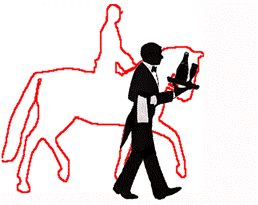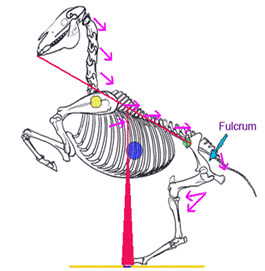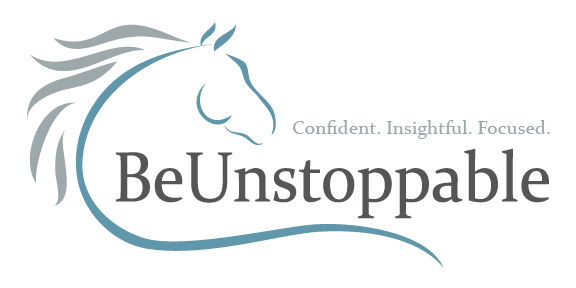I’ve never seen collection explained so well. I hope you enjoy this as much as I did!
A horse’s weight is distributed over its haunches and forehand. However, because of the heavy head and neck, the horse carries a greater amount of its weight on its forehand. The horse’s center of gravity is located slightly above and behind its elbow (blue dot).
There is a belief that the front feet push against the ground in order to push the forehand upward and the body weight backward but by watching correctly ridden horses and horse playing in nature, it becomes clear that this is not the case.

To improve the horse’s balance we need to encourage the horse to carry more of its weight with its haunches or, in other words, engage its haunches.
Equilibrium is maintained by controlling
the body’s center of
gravity over its base of support.

KEY FACTORS THAT CONTRIBUTE TO ENGAGEMENT OF THE HAUNCHES
The bending of the hind legs – When the horse is working in a relaxed manner and his back is elastically pulsating, the driving aids can be used to encourage pure impulsive ground covering strides, which in turn cause deeper bending of the joints of the hind legs.
The shortening of the base of support – In the beginning of the horse’s training, gymnastic exercises are used that increase the bending of the horse’s spine and the bending of one hind leg at a time. These exercises would include work on a single track such as circles, serpentines and other bent lines. Later, greater bending is developed with the use of shoulder fore and shoulder in. In more advanced training, exercises that bend both hind legs (stops, transitions, backing) are used. These gymnastic exercises encourage the more deeply bending hind legs to work further forward toward the horse’s center of gravity and shorten the horse’s base of support. This causes the forward impulse of the hind legs to travel through the horse’s body and act on the forehand in a more forward/upward direction. In addition, the shortening of the horse’s base of support shifts more weight to the haunches.
The lowering of the spine posteriorly – As the horse’s strength develops, the deeper bending of the hind legs causes the spine, which naturally slopes downward from the hips to base of the neck, to lower posteriorly. In exceptionally strong and well-conformed horses the point of the hip (green dot) can eventually lower to a point below the joint between the first thoracic vertebra (back) and last cervical (neck) vertebra (yellow dot). Because the horse’s spine is somewhat rigid, the horse’s haunches do not ‘sit’ independently from the forehand. Instead, this rearward spinal tilt shifts more weight onto the haunches. Bending of the haunches to this degree requires an extraordinary amount of strength and suppleness.
The elastic tension of the lifter muscles – As the horse’s muscles alternately flex and relax more deeply, the bending of the hind legs and shortening of the base of support create an elastic tension (not to be confused with tightness or constriction) in the muscles and ligaments that connect the haunches to the forehand. This elastic tension helps to lighten the forehand in a kind of cantilever action.
Natural raising of the neck – The elastic tension of the muscles and ligaments bring the horse’s neck up into a graceful arch, with the poll balancing as the highest point and the head hanging naturally by gravity from an elegant upward/forward reaching neck.
The horse naturally raises its mouth to a point approximately level with its hip and its face approaches the vertical. This naturally offered posture allows the rein aids to travel freely through each vertebra, through the pelvis, down to the hind pastern joints. With the neck stretched upward and the poll carried poised like a ballet dancer, the heavy weight of the head and neck is shifted toward the haunches, making it easier for the back to lift the forehand and the hind legs to carry the weight.

In the piaffe, the combined center of gravity
of the horse and rider is directly over the center
of the horse’s base of support.




Relaxing and bending is the key factor that enables the hind legs to bend more deeply under the increased weight. Engagement becomes easier for the horse as it gets stronger and its balance is refined. As the horse willingly relaxes into the work it will naturally offer to bend its hind legs as much as it is able. As the horse relaxes and settles onto its hind legs, the hips and stifles bend even further. Again, this shortens the base of support and further lowers the spine posteriorly and naturally continues to draw the head and neck into a position that enhances the horse’s balance. The haunches are methodically strengthened until the forehand can be easily lifted completely off of the ground and the horse can momentarily settle onto its hind legs.

Thank you for your sharing. I am worried that I lack creative ideas. It is your article that makes me full of hope. Thank you. But, I have a question, can you help me?
Can you be more specific about the content of your article? After reading it, I still have some doubts. Hope you can help me. https://www.binance.com/fr/register?ref=GJY4VW8W
Great article with clear illustrations. Classical and correct. Thank you!
This was great Barbra!! Thank you!!! I understand how to “teach” my horses to collect, but this really illustrates why it is so important, and how we need to “develop” the muscles needed to do this successfully. Thank you ❤
so what exercises can we do with older western horses to get them off the forehand
What I have done is to cue them into a jog, (or even start with a walk), do a simple stop, “gentle stop”, back up a step or 2 and then move out directly into a jog again. It gets them to sit back – with out a lot of stress – and then move off that position. I’ve had a lot of success with this very simple move 🙂 Of course you have to give them the release at the jog (and praise) when they hold that position.